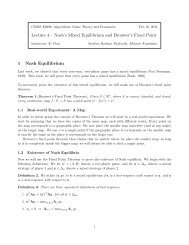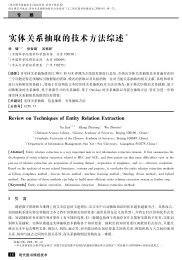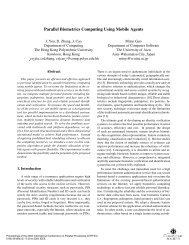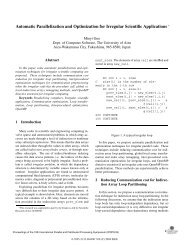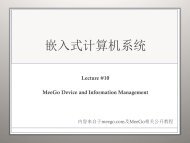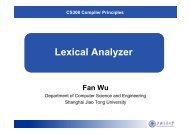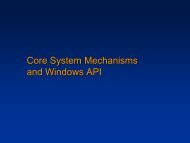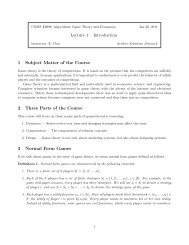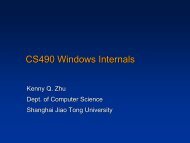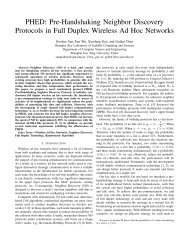Information Extraction - University of Utah School of Computing
Information Extraction - University of Utah School of Computing
Information Extraction - University of Utah School of Computing
Create successful ePaper yourself
Turn your PDF publications into a flip-book with our unique Google optimized e-Paper software.
Chapter 21<strong>Information</strong> <strong>Extraction</strong>Jerry R. Hobbs, <strong>University</strong> <strong>of</strong> Southern CaliforniaEllen Ril<strong>of</strong>f, <strong>University</strong> <strong>of</strong> <strong>Utah</strong>21.1 Introduction . . . . . . . . . . . . . . . . . . . . . . . . . . . . . . . . . . . . . . . . . . . . . . . . . . . . . . . . . . . . . 121.2 Diversity <strong>of</strong> IE Tasks . . . . . . . . . . . . . . . . . . . . . . . . . . . . . . . . . . . . . . . . . . . . . . . . . . . . 421.3 IE with Cascaded Finite-State Transducers . . . . . . . . . . . . . . . . . . . . . . . . . . . . . 821.4 Learning-based Approaches to IE . . . . . . . . . . . . . . . . . . . . . . . . . . . . . . . . . . . . . . . 1621.5 How Good is <strong>Information</strong> <strong>Extraction</strong>? . . . . . . . . . . . . . . . . . . . . . . . . . . . . . . . . . . 2121.6 Acknowledgments . . . . . . . . . . . . . . . . . . . . . . . . . . . . . . . . . . . . . . . . . . . . . . . . . . . . . . . . 23Bibliography . . . . . . . . . . . . . . . . . . . . . . . . . . . . . . . . . . . . . . . . . . . . . . . . . . . . . . . . . . . . . 23Abstract <strong>Information</strong> <strong>Extraction</strong> (IE) techniques aim to extract the names<strong>of</strong> entities and objects from text and to identify the roles that they play inevent descriptions. IE systems generally focus on a specific domain or topic,searching only for information that is relevant to a user’s interests. In thischapter, we first give historical background on information extraction and discussseveral kinds <strong>of</strong> information extraction tasks that have emerged in recentyears. Next, we outline the series <strong>of</strong> steps that are involved in creating a typicalinformation extraction system, which can be encoded as a cascaded finitestatetransducer. Along the way, we present examples to illustrate what eachstep does. Finally, we present an overview <strong>of</strong> different learning-based methodsfor information extraction, including supervised learning approaches, weaklysupervised and bootstrapping techniques, and discourse-oriented approaches.21.1 Introduction<strong>Information</strong> extraction (IE) is the process <strong>of</strong> scanning text for informationrelevant to some interest, including extracting entities, relations, and, mostchallenging, events–or who did what to whom when and where. It requiresdeeper analysis than key word searches, but its aims fall short <strong>of</strong> the veryhard and long-term problem <strong>of</strong> text understanding, where we seek to captureall the information in a text, along with the speaker’s or writer’s intention.1
2 Handbook <strong>of</strong> Natural Language Processing<strong>Information</strong> extraction represents a midpoint on this spectrum, where theaim is to capture structured information without sacrificing feasibility. IEtypically focuses on surface linguistic phenomena that do not require deepinference, and it focuses on the phenomena that are most frequent in texts.<strong>Information</strong> extraction technology arose in response to the need for efficientprocessing <strong>of</strong> texts in specialized domains. Full-sentence parsers expended alot <strong>of</strong> effort in trying to arrive at parses <strong>of</strong> long sentences that were not relevantto the domain, or which contained much irrelevant material, therebyincreasing the chances for error. <strong>Information</strong> extraction technology, by contrast,focuses in on only the relevant parts <strong>of</strong> the text and ignores the rest.Typical applications <strong>of</strong> information extraction systems are in gleaning business,government, or military intelligence from a large number <strong>of</strong> sources; insearches <strong>of</strong> the World Wide Web for more specific information than keywordscan discriminate; for scientific literature searches; in building databases fromlarge textual corpora; and in the curation <strong>of</strong> biomedical articles. The need forinformation extraction is well illustrated in biomedicine, where there are morethan half a million articles a year, and large amounts <strong>of</strong> money are spent oncuratorial activities. Similarly, in intelligence gathering, an analyst in 1990said that reading everything she was supposed to read would be like readingWar and Peace every day; in 1995 the same analyst said it was way beyondthat.Named entity recognition (NER) is one <strong>of</strong> the most common uses <strong>of</strong> informationextraction technology (e.g., (Bikel, Schwartz, and Weischedel 1999;Collins and Singer 1999; Cucerzan and Yarowsky 1999; Fleischman and Hovy2002; Sang and Meulder 2003)).NER systems identify different types <strong>of</strong> proper names, such as person andcompany names, and sometimes special types <strong>of</strong> entities, such as dates andtimes, that can be easily identified using surface-level textual patterns. NERis especially important in biomedical applications, where terminology is aformidable problem. But it is important to note that information extractionis much more than just named entity recognition. A much more difficult andpotentially much more significant capability is the recognition <strong>of</strong> events andtheir participants. For example, in each <strong>of</strong> the sentences:“Micros<strong>of</strong>t acquired Powerset.”“Powerset was acquired by Micros<strong>of</strong>t.”we would like to recognize not only that Micros<strong>of</strong>t and Powerset are companynames, but also that an acquisition event took place, that the acquiringcompany was Micros<strong>of</strong>t, and the acquired company was Powerset.Much <strong>of</strong> the technology in information extraction was developed in responseto a series <strong>of</strong> evaluations and associated conferences called the Message UnderstandingConference (MUC), held between 1987 and 1998.Except for the earliest MUCs, these evaluations were based on a corpus <strong>of</strong>domain-specific texts, such as news articles on joint ventures. Participatingteams were supplied with a training corpus and a template definition for
<strong>Information</strong> <strong>Extraction</strong> Jerry R. Hobbs, <strong>University</strong> <strong>of</strong> Southern California Ellen Ril<strong>of</strong>f, <strong>University</strong> <strong>of</strong> <strong>Utah</strong> 3the events and their roles. For joint ventures, the roles were such things asthe participating companies, the joint venture company that was formed, theactivity it would engage in, and the amount <strong>of</strong> money it was capitalized for.The systems were then run on a previously unseen test corpus. A system’sperformance was measured on recall (what percentage <strong>of</strong> the correct answersdid the system get), precision (what percentage <strong>of</strong> the system’s answers werecorrect), and F-score. F-score is a a weighted harmonic mean between recalland precision computed by the following formula:F = (β2 +1)P Rβ 2 P +Rwhere P is precision, R is recall, and β is a parameter encoding the relativeimportance <strong>of</strong> recall and precision. If β = 1, they are weighted equally. Ifβ > 1, precision is more important; if β < 1, recall is more important. 1A typical text in the joint ventures domain used in MUC-5 (July 1993)(MUC-5 Proceedings 1993) is the following:Bridgestone Sports Co. said Friday it has set up a joint venturein Taiwan with a local concern and a Japanese trading house toproduce golf clubs to be shipped to Japan.The joint venture, Bridgestone Sports Taiwan Co., capitalizedat 20 million new Taiwan dollars, will start production in January1990 with production <strong>of</strong> 20,000 iron and “metal wood” clubs amonth.The information to be extracted from this text is shown in the followingtemplates:TIE-UP-1:Relationship:Entities:Joint Venture Company:Activity:Amount:TIE-UP“Bridgestone Sports Co.”“a local concern”“a Japanese trading house”“Bridgestone Sports Taiwan Co.”ACTIVITY-1NT$20000000ACTIVITY-1:Activity:PRODUCTIONCompany:“Bridgestone Sports Taiwan Co.”Product:“iron and ‘metal wood’ clubs”Start Date: DURING: January 19901 When in a courtroom you promise to tell the whole truth, you are promising 100% recall.When you promise to tell nothing but the truth, you are promising 100% precision.
4 Handbook <strong>of</strong> Natural Language ProcessingIE research has since been stimulated by the Automatic Content <strong>Extraction</strong>(ACE) evaluations 2 . The ACE evaluations have focused on identifying namedentities, extracting isolated relations, and coreference resolution.<strong>Information</strong> extraction systems have been developed for a variety <strong>of</strong> domains,including terrorist events (MUC-4 Proceedings 1992; Chieu, Ng, andLee 2003; Ril<strong>of</strong>f 1996b; Soderland, Fisher, Aseltine, and Lehnert 1995), jointventures (MUC-5 Proceedings 1993), management succession (MUC-6 Proceedings1995), plane crashes (MUC-7 Proceedings 1998), vehicle launches (MUC-7 Proceedings 1998), corporate acquisitions (Freitag 1998b; Freitag and Mc-Callum 2000; Finn and Kushmerick 2004), disease outbreaks (Grishman, Huttunen,and Yangarber 2002; Patwardhan and Ril<strong>of</strong>f 2007; Phillips and Ril<strong>of</strong>f2007), job postings (Califf and Mooney 2003; Freitag and McCallum 2000),rental ads (Soderland 1999; Ciravegna 2001), resumes (Yu, Guan, and Zhou2005), and seminar announcements (Freitag 1998b; Ciravegna 2001; Chieuand Ng 2002; Califf and Mooney 2003; Finn and Kushmerick 2004; Gu andCercone 2006), There has also been a great deal <strong>of</strong> work on information extractionin biological and medical domains (e.g., (Friedman 1986; Subramaniam,Mukherjea, Kankar, Srivastava, Batra, Kamesam, and Kothari 2003; Ananiadou,Friedman, and Tsujii 2004; Hirschman, Yeh, Blaschke, and Valencia2005; Yakushiji, Miyao, Ohta, and Tateisi 2006; Ananiadou and McNaught2006)), which is discussed in greater depth in the BioNLP chapter <strong>of</strong> thisbook.21.2 Diversity <strong>of</strong> IE TasksThe Message Understanding Conferences led to an increased interest in theIE task and the creation <strong>of</strong> additional IE data sets. Researchers began towork on IE problems for new domains and focused on different aspects <strong>of</strong> theinformation extraction problem. In the following sections, we outline some <strong>of</strong>the fundamental distinctions that cut across different information extractiontasks.21.2.1 Unstructured vs. Semi-Structured TextHistorically, most natural language processing systems have been designedto process unstructured text, which consists <strong>of</strong> natural language sentences. Incontrast to structured data where the semantics <strong>of</strong> the data is defined byits organization (e.g., database entries), the meaning <strong>of</strong> unstructured textdepends entirely on linguistic analysis and natural language understanding.2 http://www.itl.nist.gov/iad/mig/tests/ace/
<strong>Information</strong> <strong>Extraction</strong> Jerry R. Hobbs, <strong>University</strong> <strong>of</strong> Southern California Ellen Ril<strong>of</strong>f, <strong>University</strong> <strong>of</strong> <strong>Utah</strong> 5Pr<strong>of</strong>essor John Skvoretz, U. <strong>of</strong> South Carolina, Columbia, willpresent a seminar entitled “Embedded Commitment,” on Thursday,May 4th from 4-5:30 in PH 223D.FIGURE 21.1: Example <strong>of</strong> an unstructured seminar announcementExamples <strong>of</strong> unstructured text include news stories, magazine articles, andbooks. 3 Figure 21.1 shows an example <strong>of</strong> a seminar announcement that iswritten as unstructured text.Semi-structured text consists <strong>of</strong> natural language that appears in a documentwhere the physical layout <strong>of</strong> the language plays a role in its intepretation.For example, consider the seminar announcements depicted in Figure 21.2.The reader understands that the speaker is Laura Petitte, who is from theDepartment <strong>of</strong> Psychology at McGill <strong>University</strong>, because seminar speakersand their affiliations typically appear at the top <strong>of</strong> a seminar announcement.If McGill <strong>University</strong> had appeared below Baker Hall 355 in the announcement,then we would assume that the seminar takes place at McGill <strong>University</strong>.Several IE data sets have been created specifically to handle domains that<strong>of</strong>ten include semi-structured text, such as seminar announcements, job postings,rental ads, and resumes. To accommodate semi-structured text, IE systemstypically rely less on syntactic parsing and more on positional featuresthat capture the physical layout <strong>of</strong> the words on the page.21.2.2 Single-Document vs. Multi-Document IEOriginally, information extraction systems were designed to locate domainspecificinformation in individual documents. Given a document as input, theIE system identifies and extracts facts relevant to the domain that appearin the document. We will refer to this task as single-document informationextraction.The abundance <strong>of</strong> information available on the Web has led to the creation<strong>of</strong> new types <strong>of</strong> IE systems that seek to extract facts from the Web or othervery large text collections (e.g., (Brin 1998; Fleischman, Hovy, and Echihabi2003; Etzioni, Cafarella, Popescu, Shaked, Soderland, Weld, and Yates 2005;Pasca, Lin, Bigham, Lifchits, and Jain 2006; Pasca 2007; Banko, Cafarella,Soderland, Broadhead, and Etzioni 2007)). We will refer to this task as multidocumentinformation extractionSingle-document IE is fundamentally different from multi-document IE, althoughboth types <strong>of</strong> systems may use similar techniques. One distinguishingissue is redundancy. A single-document IE system must extract domain-3 These text forms can include some structured information as well, such as publicationdates and author by-lines. But most <strong>of</strong> the text in these genres is unstructured.
6 Handbook <strong>of</strong> Natural Language ProcessingLaura PetitteDepartment <strong>of</strong> PsychologyMcGill <strong>University</strong>Thursday, May 4, 199512:00 pmBaker Hall 355Name: Dr. Jeffrey D. HermesAffiliation: Department <strong>of</strong> AutoImmune DiseasesResearch & Biophysical Chemistry Merck Research LaboratoriesTitle: “MHC Class II: A Target for Specific Immunomodulation <strong>of</strong>the Immune Response”Host/e-mail: Robert Murphy, murph@a.crf.cmu.eduDate: Wednesday, May 3, 1995Time: 3:30 p.m.Place: Mellon Institute Conference RoomSponsor: MERCK RESEARCH LABORATORIESFIGURE 21.2: Examples <strong>of</strong> semi-structured seminar announcementsspecific information from each document that it is given. If the system failsto find relevant information in a document, then that is an error. This taskis challenging because many documents mention a fact only once, and thefact may be expressed in an unusual or complex linguistic context (e.g., onerequiring inference). In contrast, multi-document IE systems can exploit theredundancy <strong>of</strong> information in its large text collection. Many facts will appearin a wide variety <strong>of</strong> contexts, so the system usually has multiple opportunitiesto find each piece <strong>of</strong> information. The more <strong>of</strong>ten a fact appears, the greaterthe chance that it will occur at least once in a linguistically simple contextthat will be straightforward for the IE system to recognize. 4Multi-document IE is sometimes referred to as “open-domain” IE becausethe goal is usually to acquire broad-coverage factual information, which willlikely benefit many domains. In this paradigm, it doesn’t matter where the informationoriginated. Some open-domain IE systems, such as KnowItAll (Etzioni,Cafarella, Popescu, Shaked, Soderland, Weld, and Yates 2005) and TextRunner(Banko, Cafarella, Soderland, Broadhead, and Etzioni 2007), have4 This issue parallels the difference between single-document and multi-document questionanswering (QA) systems. Light et al. (Light, Mann, Ril<strong>of</strong>f, and Breck 2001) found that theperformance <strong>of</strong> QA systems in TREC-8 was directly correlated with the number <strong>of</strong> answeropportunities available for a question.
<strong>Information</strong> <strong>Extraction</strong> Jerry R. Hobbs, <strong>University</strong> <strong>of</strong> Southern California Ellen Ril<strong>of</strong>f, <strong>University</strong> <strong>of</strong> <strong>Utah</strong> 7addressed issues <strong>of</strong> scale to acquire large amounts <strong>of</strong> information from theWeb. One <strong>of</strong> the major challenges in multi-document IE is cross-documentcoreference resolution: when are two documents talking about the same entities?Some researchers have tackled this problem (e.g., (Bagga and Baldwin1998; Mann and Yarowsky 2003; Gooi and Allan 2004; Niu, Li, and Srihari2004; Mayfield, Alexander, Dorr, Eisner, Elsayed, Finin, Fink, Freedman,Garera, McNamee, Mohammad, Oard, Piatko, Sayeed, Syed, Weischedel, Xu,and Yarowsky 2009)), and in 2008 the ACE evaluation expanded its focus toinclude cross-document entity disambiguation (Strassel, Przybocki, Peterson,Song, and Maeda 2008).21.2.3 Asssumptions about Incoming DocumentsThe IE data sets used in the Message Understanding Conferences consist<strong>of</strong> documents related to the domain, but not all <strong>of</strong> the documents mention arelevant event. The data sets were constructed to mimic the challenges that areal-world information extraction system must face, where a fundamental part<strong>of</strong> the IE task is to determine whether a document describes a relevant event,as well as to extract information about the event. In the MUC-3 throughMUC-7 IE data sets, only about half <strong>of</strong> the documents describe a domainrelevantevent that warrants information extraction.Other IE data sets make different assumptions about the incoming documents.Many IE data sets consist only <strong>of</strong> documents that describe a relevantevent. Consequently, the IE system can assume that each document containsinformation that should be extracted. This assumption <strong>of</strong> relevant-only documentsallows an IE system to be more aggressive about extracting informationbecause the texts are known to be on-topic. For example, if an IE system isgiven stories about bombing incidents, then it can extract the name <strong>of</strong> everyperson who was killed or injured and in most cases they will be victims <strong>of</strong> abombing. If, however, irrelevant stories are also given to the system, then itmust further distinguish between people who are bombing victims and peoplewho were killed or injured in other types <strong>of</strong> events, such as robberies or carcrashes.Some IE data sets further make the assumption that each incoming documentcontains only one event <strong>of</strong> interest. We will refer to these as singleeventdocuments. The seminar announcements, corporate acquisitions, andjob postings IE data sets only contain single-event documents. In contrast,the MUC data sets and some others (e.g., rental ads and disease outbreaks)allow that a single document may describe multiple events <strong>of</strong> interest. If theIE system can assume that each incoming document describes only one relevantevent, then all <strong>of</strong> the extracted information can be inserted in a singleoutput template. 5 If multiple events are discussed in a document, then the5 Note that coreference resolution <strong>of</strong> entities is still an issue, however. For example, a
8 Handbook <strong>of</strong> Natural Language ProcessingIE system must perform discourse analysis to determine how many differentevents are being reported and to associate each piece <strong>of</strong> extracted informationwith the appropriate event template.21.3 IE with Cascaded Finite-State TransducersProbably the most important idea that emerged in the course <strong>of</strong> the MUCevaluations was the decomposition <strong>of</strong> the IE process into a series <strong>of</strong> subproblemsthat can be modeled with “cascaded finite-state transducers” (Lehnert,Cardie, Fisher, Ril<strong>of</strong>f, and Williams 1991; Hobbs, Appelt, Bear, Israel, andTyson 1992; Hobbs, Appelt, Bear, Israel, Kameyama, Stickel, and Tyson1997; Joshi 1996; Cunningham, Maynard, Bontcheva, and Tablan 2002). Afinite-state automaton reads one element at a time <strong>of</strong> a sequence <strong>of</strong> elements;each element transitions the automaton into a new state, based on the type<strong>of</strong> element it is, e.g., the part <strong>of</strong> speech <strong>of</strong> a word. Some states are designatedas final, and a final state is reached when the sequence <strong>of</strong> elements matchesa valid pattern. In a finite-state transducer, an output entity is constructedwhen final states are reached, e.g., a representation <strong>of</strong> the information in aphrase. In a cascaded finite-state transducer, there are different finite-statetransducers at different stages. Earlier stages will package a string <strong>of</strong> elementsinto something the next stage will view as a single element.In the typical system, the earlier stages recognize smaller linguistic objectsand work in a largely domain-independent fashion. They use purely linguisticknowledge to recognize portions <strong>of</strong> the syntactic structure <strong>of</strong> a sentence thatlinguistic methods can determine reliably, requiring relatively little modificationor augmentation as the system is moved from domain to domain. Thelater stages take these linguistic objects as input and find domain-dependentpatterns within them. In a typical IE system, there are five levels <strong>of</strong> processing:1. Complex Words: This includes the recognition <strong>of</strong> multiwords and propername entities, such as people, companies, and countries.2. Basic Phrases: Sentences are segmented into noun groups, verb groups,and particles.3. Complex Phrases: Complex noun groups and complex verb groups areidentified.document may mention multiple victims so the IE system needs to determine whether anextracted victim refers to a previously mentioned victim or a new one.
<strong>Information</strong> <strong>Extraction</strong> Jerry R. Hobbs, <strong>University</strong> <strong>of</strong> Southern California Ellen Ril<strong>of</strong>f, <strong>University</strong> <strong>of</strong> <strong>Utah</strong> 94. Domain Events: The sequence <strong>of</strong> phrases produced at Level 3 is scannedfor patterns <strong>of</strong> interest to the application, and when they are found,semantic structures are built that encode the information about entitiesand events contained in the pattern.5. Merging Structures: Semantic structures from different parts <strong>of</strong> the textare merged if they provide information about the same entity or event.This process is sometimes called template generation, and is a complexprocess not done by a finite-state transducer.As we progress through the five levels, larger segments <strong>of</strong> text are analyzedand structured. In each <strong>of</strong> stages 2 through 4, the input to the finite-statetransducer is the sequence <strong>of</strong> chunks constructed in the previous stage. TheGATE project (Cunningham, Maynard, Bontcheva, and Tablan 2002) is awidely used toolkit that provides many <strong>of</strong> the components needed for such anIE pipeline.This decomposition <strong>of</strong> the natural-language problem into levels is essentialto the approach. Many systems have been built to do pattern matching onstrings <strong>of</strong> words. The advances in information extraction have depended cruciallyon dividing that process into separate levels for recognizing phrases andrecognizing patterns among the phrases. Phrases can be recognized reliablywith purely syntactic information, and they provide precisely the elementsthat are required for stating the patterns <strong>of</strong> interest.In the next five sections we illustrate this process on the Bridgestone Sportstext.21.3.1 Complex WordsThe first level <strong>of</strong> processing identifies multiwords such as “set up”, “tradinghouse”, “new Taiwan dollars”, and “joint venture”, and company nameslike “Bridgestone Sports Co.” and “Bridgestone Sports Taiwan Co.”. Thenames <strong>of</strong> people and locations, dates, times, and other basic entities are alsorecognized at this level. Languages in general are very productive in theconstruction <strong>of</strong> short, multiword fixed phrases and proper names employingspecialized microgrammars, and this is the level at which they are recognized.Some names can be recognized by their internal structure. A commonpattern for company names is “ProperName ProductName”, as in “AcmeWidgets”. Others can only be recognized by means <strong>of</strong> a table. Internalstructure cannot tell us that IBM is a company and DNA is not. It is alsosometimes possible to recognize the types <strong>of</strong> proper names by the context inwhich they occur. For example, in the sentences below:(a) XYZ’s sales(b) Vaclav Havel, 53, president <strong>of</strong> the Czech Republicwe might not know that XYZ is a company and Vaclav Havel is a person, but
10 Handbook <strong>of</strong> Natural Language Processingthe immediate context establishes that. These can be given an underspecifiedrepresentation that is resolved by later stages.21.3.2 Basic PhrasesThe problem <strong>of</strong> syntactic ambiguity in natural language is AI-complete.That is, we will not have systems that reliably parse English sentences correctlyuntil we have encoded much <strong>of</strong> the real-world knowledge that peoplebring to bear in their language comprehension. For example, noun phrasescannot be reliably identified because <strong>of</strong> the prepositional phrase attachmentproblem. However, certain syntactic constructs can be identified with reasonablereliability. One <strong>of</strong> these is the noun group, which is the head noun <strong>of</strong>a noun phrase together with its determiners and other left modifiers (theseare sometimes called “base NPs”). Another is what we are calling the “verbgroup”, that is, the verb together with its auxiliaries and any intervening adverbs.Moreover, an analysis that identifies these elements gives us exactly theunits we most need for subsequent domain-dependent processing. The task <strong>of</strong>identifying these simple noun and verb groups is sometimes called “syntacticchunking”. The basic phrases in the first sentence <strong>of</strong> text (1) are as follows,where “Company Name” and “Location” are special kinds <strong>of</strong> noun group thatwould be identified by named entity recognition:Company Name:Verb Group:Noun Group:Noun Group:Verb Group:Noun Group:Preposition:Location:Preposition:Noun Group:Conjunction:Noun Group:Verb Group:Noun Group:Verb Group:Preposition:Location:Bridgestone Sports Co.saidFridayithad set upa joint ventureinTaiwanwitha local concernanda Japanese trading houseto producegolf clubsto be shippedtoJapanNoun groups can be recognized by a relatively simple finite-state grammarencompassing most <strong>of</strong> the complexity that can occur in English noun groups(Hobbs et al., 1992), including numbers, numerical modifiers like “approximately”,other quantifiers and determiners, participles in adjectival position,comparative and superlative adjectives, conjoined adjectives, and arbitrary or-
<strong>Information</strong> <strong>Extraction</strong> Jerry R. Hobbs, <strong>University</strong> <strong>of</strong> Southern California Ellen Ril<strong>of</strong>f, <strong>University</strong> <strong>of</strong> <strong>Utah</strong> 11derings and conjunctions <strong>of</strong> prenominal nouns and noun-like adjectives. Thus,among the noun groups that can be recognized are:“approximately 5 kg”“more than 30 people”“the newly elected president”“the largest leftist political force”“a government and commercial project”The principal ambiguities that arise in this stage are due to noun-verb ambiguities.For example, “the company names” could be a single noun group withthe head noun “names”, or it could be a noun group “the company” followedby the verb “names”. One can use a lattice representation to encode the twoanalyses and resolve the ambiguity in the stage for recognizing domain events.Verb groups (and predicate adjective constructions) can be recognized by aneven simpler finite-state grammar that, in addition to chunking, also tags themas Active Voice, Passive Voice, Gerund, and Infinitive. Verbs are sometimeslocally ambiguous between active and passive senses, as the verb “kidnapped”in the following two sentences:“Several men kidnapped the mayor today.”“Several men kidnapped yesterday were released today.”These cases can be tagged as Active/Passive, and the domain-event stage canlater resolve the ambiguity. Some work has also been done to train a classifierto distinguish between active voice and “reduced” passive voice constructions(Igo and Ril<strong>of</strong>f 2008).The breakdown <strong>of</strong> phrases into nominals, verbals, and particles is a linguisticuniversal. Whereas the precise parts <strong>of</strong> speech that occur in any language canvary widely, every language has elements that are fundamentally nominal incharacter, elements that are fundamentally verbal or predicative, and particlesor inflectional affixes that encode relations among the other elements (Cr<strong>of</strong>t1991).21.3.3 Complex PhrasesSome complex noun groups and verb groups can be recognized reliably onthe basis <strong>of</strong> domain-independent, syntactic information. For example:• the attachment <strong>of</strong> appositives to their head noun group“The joint venture, Bridgestone Sports Taiwan Co.,”• the construction <strong>of</strong> measure phrases“20,000 iron and “metal wood” clubs a month”• the attachment <strong>of</strong> “<strong>of</strong>” and “for” prepositional phrases to their headnoun groups
12 Handbook <strong>of</strong> Natural Language Processing“production <strong>of</strong> 20,000 iron and “metal wood” clubs a month”• noun group conjunction“a local concern and a Japanese trading house”In the course <strong>of</strong> recognizing basic and complex phrases, domain-relevantentities and events can be recognized and the structures for these can beconstructed. In the sample joint-venture text, entity structures can be constructedfor the companies referred to by the phrases “Bridgestone SportsCo.”, “a local concern”, “a Japanese trading house”, and “Bridgestone SportsTaiwan Co.” <strong>Information</strong> about nationality derived from the words “local”and “Japanese” can be recorded. Corresponding to the complex noun group“The joint venture, Bridgestone Sports Taiwan Co.,” the following relationshipstructure can be built:Relationship:TIE-UPEntities: –Joint Venture Company: “Bridgestone Sports Taiwan Co.”Activity: –Amount: –Corresponding to the complex noun group “production <strong>of</strong> 20,000 iron and‘metal wood’ clubs a month”, the following activity structure can be built up:Activity:PRODUCTIONCompany: –Product:“iron and ‘metal wood’ clubs”Start Date: –Complex verb groups can also be recognized in this stage. Consider thefollowing variations:“GM formed a joint venture with Toyota.”“GM announced it was forming a joint venture with Toyota.”“GM signed an agreement forming a joint venture with Toyota.”“GM announced it was signing an agreement to form a joint venturewith Toyota.”Although these sentences may differ in significance for some applications, <strong>of</strong>tenthey would be considered equivalent in meaning. Rather than defining each<strong>of</strong> these variations, with all their syntactic variants, at the domain eventlevel, the user should be able to define complex verb groups that share thesame significance. Thus, “formed”, “announced it was forming”, “signed anagreement forming”, and “announced it was signing an agreement to form”may all be equivalent, and once they are defined to be so, only one domainevent pattern needs to be expressed. Verb group conjunction, as in“Terrorists kidnapped and killed three people.”can be treated as a complex verb group as well.
<strong>Information</strong> <strong>Extraction</strong> Jerry R. Hobbs, <strong>University</strong> <strong>of</strong> Southern California Ellen Ril<strong>of</strong>f, <strong>University</strong> <strong>of</strong> <strong>Utah</strong> 1321.3.4 Domain EventsThe next stage is recognizing domain events, and its input is a a list <strong>of</strong>the basic and complex phrases recognized in the earlier stages, in the orderin which they occur. Anything that was not identified as a basic or complexphrase in a previous stage can be ignored in this stage; this can be a significantsource <strong>of</strong> robustness.Identifying domain events requires a set <strong>of</strong> domain-specific patterns bothto recognize phrases that correspond to an event <strong>of</strong> interest and to identifythe syntactic constitutents that correspond to the event’s role fillers. In earlyinformation systems, these domain-specific “extraction patterns” were definedmanually. In Sections 21.4.1 and 21.4.3, we describe a variety <strong>of</strong> learningmethods that have subsequently been developed to automatically generatedomain-specific extraction patterns from training corpora.The patterns for events <strong>of</strong> interest can be encoded as finite-state machines,where state transitions are effected by phrases. The state transitions aredriven <strong>of</strong>f the head words in the phrases. That is, each pair <strong>of</strong> relevanthead word and phrase type—such as “company-NounGroup” and “formed-PassiveVerbGroup”— has an associated set <strong>of</strong> state transitions. In the samplejoint-venture text, the domain event patternsand with would be instantiated in the first sentence, and the patternsand at in/on in the second. These four patterns would result in the following four structuresbeing built:Relationship:Entities:Joint Venture Company: –Activity: –Amount: –TIE-UP“Bridgestone Sports Co.”“a local concern”“a Japanese trading house”Activity:PRODUCTIONCompany: –Product:“golf clubs”Start Date: –
14 Handbook <strong>of</strong> Natural Language ProcessingRelationship:TIE-UPEntities: –Joint Venture Company: “Bridgestone Sports Taiwan Co.”Activity: –Amount:NT$20000000Activity:PRODUCTIONCompany:“Bridgestone Sports Taiwan Co.”Product: –Start Date: DURING: January 1990The third <strong>of</strong> these is an augmentation <strong>of</strong> the TIE-UP structure discoveredin the complex phrase phase.Certain kinds <strong>of</strong> “pseudo-syntax” can be done at this stage, including recognizingrelative clauses and conjoined verb phrases, as described in Hobbs etal. (1997).Many subject-verb-object patterns are <strong>of</strong> course related to each other. Thesentence:“GM manufactures cars.”illustrates a general pattern for recognizing a company’s activities. But thesame semantic content can appear in a variety <strong>of</strong> ways, including“Cars are manufactured by GM.”“. . . GM, which manufactures cars. . .”“. . . cars, which are manufactured by GM. . .”“. . . cars manufactured by GM . . .”“GM is to manufacture cars.”“Cars are to be manufactured by GM.”“GM is a car manufacturer.”These are all systematically related to the active voice form <strong>of</strong> the sentence.Therefore, there is no reason a developer should have to specify all the variations.A simple tool would be able to generate all <strong>of</strong> the variants <strong>of</strong> the patternfrom the simple active voice Subject-Verb-Object form. It would also allowadverbials to appear at appropriate points. These transformations would beexecuted at compile time, producing the more detailed set <strong>of</strong> patterns, so thatat run time there is no loss <strong>of</strong> efficiency.This feature is not merely a clever idea for making a system more convenientto author. It rests on the fundamental idea that underlies generativetransformational grammar, but is realized in a way that does not impact theefficiency <strong>of</strong> processing.In recent years, full-sentence parsing has improved, in large part throughthe use <strong>of</strong> statistical techniques. Consequently, some IE systems have begunto rely on full parsers rather than shallow parsing techniques.
<strong>Information</strong> <strong>Extraction</strong> Jerry R. Hobbs, <strong>University</strong> <strong>of</strong> Southern California Ellen Ril<strong>of</strong>f, <strong>University</strong> <strong>of</strong> <strong>Utah</strong> 1521.3.5 Template Generation: Merging StructuresThe first four stages <strong>of</strong> processing all operate within the bounds <strong>of</strong> singlesentences. The final level <strong>of</strong> processing operates over the whole text. Its taskis to see that all the information collected about a single entity, relationship,or event is combined into a unified whole. This is one <strong>of</strong> the primary ways thatthe problem <strong>of</strong> coreference is dealt with in information extraction, includingboth NP coreference (for entities) and event coreference. One event templateis generated for each event, which coalesces all <strong>of</strong> the information associatedwith that event. If an input document discusses multiple events <strong>of</strong> interest,then the IE system must generate multiple event templates. Generating multipleevent templates requires additional discourse analysis to (a) correctlydetermine how many distinct events are reported in the document, and (b)correctly assign each entity and object to the appropriate event template.Among the criteria that need to be taken into account in determiningwhether two structures can be merged are the internal structure <strong>of</strong> the noungroups, nearness along some metric, and the consistency, or more generally,the compatibility <strong>of</strong> the two structures.In the analysis <strong>of</strong> the sample joint-venture text, we have produced threeactivity structures. They are all consistent because they are all <strong>of</strong> type PRO-DUCTION and because “iron and ‘metal wood’ clubs” is consistent with “golfclubs”. Hence, they are merged, yielding:Activity:PRODUCTIONCompany:“Bridgestone Sports Taiwan Co.”Product:“iron and ‘metal wood’ clubs”Start Date: DURING: January 1990Similarly, the two relationship structures that have been generated are consistentwith each other, so they can be merged, yielding:Relationship:Entities:Joint Venture Company:Activity: –Amount:NT$20000000TIE-UP“Bridgestone Sports Co.”“a local concern”“a Japanese trading house”“Bridgestone Sports Taiwan Co.”The entity and event coreference problems are very hard, and constituteactive and important areas <strong>of</strong> research. Coreference resolution was a task inthe later MUC evaluations (MUC-6 Proceedings 1995; MUC-7 Proceedings1998), and has been a focus <strong>of</strong> the ACE evaluations. Many recent researchefforts have applied machine learning techniques to the problem <strong>of</strong> coreferenceresolution (e.g., (Dagan and Itai 1990; McCarthy and Lehnert 1995; Aone andBennett 1996; Kehler 1997; Cardie and Wagstaff 1999; Harabagiu, Bunescu,and Maiorana 2001; Soon, Ng, and Lim 2001; Ng and Cardie 2002; Bean and
16 Handbook <strong>of</strong> Natural Language ProcessingRil<strong>of</strong>f 2004; McCallum and Wellner 2004; Yang, Su, and Tan 2005; Haghighiand Klein 2007)).Some attempts to automate the template generation process will be discussedin Section 21.4.4.21.4 Learning-based Approaches to IEAs we discussed in Section 21.3, early information extraction systems usedhand-crafted patterns and rules, <strong>of</strong>ten encoded in cascaded finite-state transducers.Hand-built IE systems were effective, but manually creating the patternsand rules was extremely time-consuming. For example, it was estimatedthat it took approximately 1500 person-hours <strong>of</strong> effort to create the patternsused by the UMass MUC-4 system (Ril<strong>of</strong>f 1993; Lehnert, Cardie, Fisher, Mc-Carthy, Ril<strong>of</strong>f, and Soderland 1992)Consequently, researchers began to use statistical techniques and machinelearning algorithms to automatically create IE systems for new domains. Inthe following sections, we overview four types <strong>of</strong> learning-based IE methods:supervised learning <strong>of</strong> patterns and rules, supervised learning <strong>of</strong> sequential IEclassifiers, weakly supervised and unsupervised learning methods for IE, andlearning-based approaches for more global or discourse-oriented approachesto IE.21.4.1 Supervised Learning <strong>of</strong> <strong>Extraction</strong> Patterns and RulesSupervised learning methods originally promised to dramatically reduce theknowledge engineering bottleneck required to create an IE system for a newdomain. Instead <strong>of</strong> painstakingly writing patterns and rules by hand, knowledgeengineering could be reduced to the manual annotation <strong>of</strong> a collection<strong>of</strong> training texts. The hope was that a training set could be annotated in amatter <strong>of</strong> weeks, and nearly anyone with knowledge <strong>of</strong> the domain could dothe annotation work. 6 As we will acknowledge in Section 21.4.3, manual annotationis itself a substantial endeavor, and a goal <strong>of</strong> recent research efforts isto eliminate this bottleneck as well. But supervised learning methods were animportant first step toward automating the creation <strong>of</strong> information extractionsystems.The earliest pattern learning systems used specialized techniques, sometimescoupled with small amounts <strong>of</strong> manual effort. AutoSlog (Ril<strong>of</strong>f 1993)and PALKA (Kim and Moldovan 1993) were the first IE pattern learning6 In contrast, creating IE patterns and rules by hand typically requires computational linguistswho understand how the patterns or rules will be integrated into the NLP system.
<strong>Information</strong> <strong>Extraction</strong> Jerry R. Hobbs, <strong>University</strong> <strong>of</strong> Southern California Ellen Ril<strong>of</strong>f, <strong>University</strong> <strong>of</strong> <strong>Utah</strong> 17systems. AutoSlog (Ril<strong>of</strong>f 1993; Ril<strong>of</strong>f 1996a) matches a small set <strong>of</strong> syntactictemplates against the text surrounding a desired extraction and createsone (or more) lexico-syntactic patterns by instantiating the templates withthe corresponding words in the sentence. A “human in the loop” must thenmanually review the patterns to decide which ones are appropriate for theIE task. PALKA (Kim and Moldovan 1993) uses manually defined framesand keywords that are provided by a user and creates IE patterns by mappingclauses containing the keywords onto the frame’s slots. The patterns aregeneralized based on the semantic features <strong>of</strong> the words.Several systems use rule learning algorithms to automatically generate IEpatterns from annotated text corpora. LIEP (Huffman 1996) creates candidatepatterns by identifying syntactic paths that relate the role fillers ina sentence. The patterns that perform well on training examples are kept,and as learning progresses they are generalized to accommodate new trainingexamples by creating disjunctions <strong>of</strong> terms. CRYSTAL (Soderland, Fisher,Aseltine, and Lehnert 1995) learns extraction rules using a unification-basedcovering algorithm. CRYSTAL’s rules are “concept node” structures that includelexical, syntactic, and semantic constraints. WHISK (Soderland 1999)was an early system that was specifically designed to be flexible enough tohandle structured, semi-structured, and unstructured texts. WHISK learnsregular expression rules that consist <strong>of</strong> words, semantic classes, and wildcardsthat match any token. (LP ) 2 (Ciravegna 2001) induces two different kinds <strong>of</strong>IE rules: tagging rules to label instances as desired extractions, and correctionrules to correct mistakes made by the tagging rules. Freitag created a rulelearningsystem called SRV (Freitag 1998b) and later combined it with a rotelearning mechanism and a Naive Bayes classifier to explore a multi-strategyapproach to IE (Freitag 1998a).Relational learning methods have also been used to learn rule-like structuresfor IE (e.g., (Roth and Yih 2001; Califf and Mooney 2003; Bunescu andMooney 2004; Bunescu and Mooney 2007)). RAPIER (Califf and Mooney1999; Califf and Mooney 2003) uses relational learning methods to generateIE rules, where each rule has a pre-filler, filler, and post-filler component.Each component is a pattern that consists <strong>of</strong> words, POS tags, and semanticclasses. Roth and Yih (Roth and Yih 2001) propose a knowledge representationlanguage for propositional relations and create a 2-stage classifier thatfirst identifies candidate extractions and then selects the best ones. Bunescuand Mooney (Bunescu and Mooney 2004) use Relational Markov Networks torepresent dependencies and influences across entities and extractions.IE pattern learning methods have also been developed for related applicationssuch as question answering (Ravichandran and Hovy 2002), where thegoal is to learn patterns for specific types <strong>of</strong> questions that involve relationsbetween entities (e.g., identifying the birth year <strong>of</strong> a person).
18 Handbook <strong>of</strong> Natural Language Processing21.4.2 Supervised Learning <strong>of</strong> Sequential Classifier ModelsAn alternative approach views information extraction as a classificationproblem that can be tackled using sequential learning models. Instead <strong>of</strong>using explicit patterns or rules to extract information, a machine learningclassifier is trained to sequentially scan text from left to right and label eachword as an extraction or a non-extraction. A typical labeling scheme is calledIOB, where each word is classified as an ’I’ if it is inside a desired extraction,’O’ if it is outside a desired extraction, or ’B’ if it is the beginning <strong>of</strong> a desiredextraction. The sentence below has been labeled with IOB tags correspondingto phrases that should be extracted as facts about a bombing incident.Alleged/B guerrilla/I urban/I commandos/I launched/O two/Bhighpower/I bombs/I against/O a/B car/I dealership/I in/O downtown/OSan/B Salvador/I this/B morning/I.In the example above, the IOB tags indicate that five phrases should be extracted:“Alleged guerrilla urban commandos”, “two highpower bombs”, “acar dealership”, “San Salvador”, and “this morning”. Note that the ‘B’ tagis important to demarcate where one extraction begins and another one ends,particularly in the case when two extractions are adjacent. For example, ifonly ’I’ and ’O’ tags were used, then “San Salvador” and “this morning” wouldrun together and appear to be a single extraction. Depending on the learningmodel, a different classifier may be trained for each type <strong>of</strong> information to beextracted (e.g., one classifier might be trained to identify perpetrator extractions,and another classifier may be trained to identify location extractions).Or a single classifier can be trained to produce different types <strong>of</strong> IOB tags forthe different kinds <strong>of</strong> role fillers (e.g., B perpetrator and B location ) (Chieu andNg 2002).A variety <strong>of</strong> sequential classifier models have been developed using HiddenMarkov Models (Freitag and McCallum 2000; Yu, Guan, and Zhou 2005;Gu and Cercone 2006), Maximum Entropy Classifiers (Chieu and Ng 2002),Conditional Random Fields (Peng and McCallum 2004; Choi, Cardie, Ril<strong>of</strong>f,and Patwardhan 2005), and Support Vector Machines (Zelenko, Aone, andRichardella 2003; Finn and Kushmerick 2004; Li, Bontcheva, and Cunningham2005; Zhao and Grishman 2005). Freitag and McCallum (Freitag andMcCallum 2000) use Hidden Markov Models and developed a method to automaticallyexplore different structures for the HMM during the learning process.Gu and Cercone (Gu and Cercone 2006) use HMMs in a 2-step IEprocess: one HMM retrieves relevant text segments that likely contain a filler,and a second HMM identifies the words to be extracted in these text segments.Finn and Kushmerick (Finn and Kushmerick 2004) also use a 2-stepIE process but in a different way: one SVM classifier identifies start and endtags for extractions, and a second SVM looks at tags that were orphaned (i.e.,a start tag was found without a corresponding end tag, or vice versa) and triesto identify the missing tag. The second classifier aims to improve IE recall by
<strong>Information</strong> <strong>Extraction</strong> Jerry R. Hobbs, <strong>University</strong> <strong>of</strong> Southern California Ellen Ril<strong>of</strong>f, <strong>University</strong> <strong>of</strong> <strong>Utah</strong> 19producing extractions that otherwise would have been missed. Yu et al. (Yu,Guan, and Zhou 2005) created a cascaded model <strong>of</strong> HMMs and SVMs. Inthe first pass, an HMM segments resumes into blocks that represent differenttypes <strong>of</strong> information. In the second pass, HMMs and SVMs extract informationfrom the blocks, with different classifiers trained to extract differenttypes <strong>of</strong> information.The chapter on Fundamental Statistical Techniques in this book explainshow to create classifiers and sequential prediction models using supervisedlearning techniques.21.4.3 Weakly Supervised and Unsupervised ApproachesSupervised learning techniques substantially reduced the manual effort requiredto create an IE system for a new domain. However, annotating trainingtexts still requires a substantial investment <strong>of</strong> time, and annotating documentsfor information extraction can be deceptively complex (Ril<strong>of</strong>f 1996b).Furthermore, since IE systems are domain-specific, annotated corpora cannotbe reused: a new corpus must be annotated for each domain.To further reduce the knowledge engineering required to create an IE system,several methods have been developed in recent years to learn extractionpatterns using weakly supervised and unsupervised techniques. AutoSlog-TS (Ril<strong>of</strong>f 1996b) is a derivative <strong>of</strong> AutoSlog that requires as input only apreclassified training corpus in which texts are identified as relevant or irrelevantwith respect to the domain but are not annotated in any other way.AutoSlog-TS’s learning algorithm is a two-step process. In the first step, AutoSlog’ssyntactic templates are applied to the training corpus exhaustively,which generates a large set <strong>of</strong> candidate extraction patterns. In the secondstep, the candidate patterns are ranked based on the strength <strong>of</strong> their associationwith the relevant texts. Ex-Disco (Yangarber, Grishman, Tapanainen,and Huttunen 2000) took this approach one step further by eliminating theneed for a preclassified text corpus. Ex-Disco uses a small set <strong>of</strong> manuallydefined seed patterns to partition a collection <strong>of</strong> unannotated text into relevantand irrelevant sets. The pattern learning process is then embedded ina bootstrapping loop where (1) patterns are ranked based on the strength <strong>of</strong>their association with the relevant texts, (2) the best pattern(s) are selectedand added to the pattern set, and (3) the corpus is re-partitioned into newrelevant and irrelevant sets. Both AutoSlog-TS and Ex-Disco produce IE patternsthat performed well in comparison to pattern sets used by previous IEsystems. However, the ranked pattern lists produced by these systems stillneed to be manually reviewed. 7Stevenson and Greenwood (Stevenson and Greenwood 2005) also begin with7 The human reviewer discards patterns that are not relevant to the IE task and assigns anevent role to the patterns that are kept.
20 Handbook <strong>of</strong> Natural Language Processingseed patterns and use semantic similarity measures to iteratively rank andselect new candidate patterns based on their similarity to the seeds. Stevensonand Greenwood use predicate-argument structures as the representation fortheir IE patterns, as did Surdeanu et al. (Surdeanu, Harabagiu, Williams,and Aarseth 2003) and Yangarber (Yangarber 2003) in earlier work. Sudo etal. (Sudo, Sekine, and Grishman 2003) created an even richer subtree modelrepresentation for IE patterns, where an IE pattern can be an arbitrary subtree<strong>of</strong> a dependency tree. The subtree patterns are learned from relevant andirrelevant training documents. Bunescu and Mooney (Bunescu and Mooney2007) developed a weakly supervised method for relation extraction that usesMultiple Instance Learning (MIL) techniques with SVMs and string kernels.Meta-bootstrapping (Ril<strong>of</strong>f and Jones 1999) is a bootstrapping method thatlearns information extraction patterns and also generates noun phrases thatbelong to a semantic class at the same time. Given a few seed nouns thatbelong to a targeted semantic class, the meta-bootstrapping algorithm iterativelylearns a new extraction pattern and then uses the learned pattern tohypothesize additional nouns that belong to the semantic class. The patternslearned by meta-bootstrapping are more akin to named entity recognition patternsthan event role patterns, however, because they identify noun phrasesthat belong to general semantic classes, irrespective <strong>of</strong> any events.Recently, Phillips and Ril<strong>of</strong>f (Phillips and Ril<strong>of</strong>f 2007) showed that bootstrappingmethods can be used to learn event role patterns by exploiting roleidentifyingnouns as seeds. A role-identifying noun is a word that, by virtue<strong>of</strong> its lexical semantics, identifies the role that the noun plays with respectto an event. For example, the definition <strong>of</strong> the word kidnapper is the agent<strong>of</strong> a kidnapping event. By using role-identifying nouns as seeds, the Basiliskbootstrapping algorithm (Thelen and Ril<strong>of</strong>f 2002) can be used to learn bothevent extraction patterns as well as additional role-identifying nouns.Finally, Shinyama and Sekine (Shinyama and Sekine 2006) have developedan approach for completely unsupervised learning <strong>of</strong> information extractionpatterns. Given texts for a new domain, relation discovery methods are usedto preemptively learn the types <strong>of</strong> relations that appear in domain-specificdocuments. The On-Demand <strong>Information</strong> <strong>Extraction</strong> (ODIE) system (Sekine2006) accepts a user query for a topic, dynamically learns IE patterns forsalient relations associated with the topic, and then applies the patterns t<strong>of</strong>ill in a table with extracted information related to the topic.21.4.4 Discourse-oriented Approaches to IEMost <strong>of</strong> the IE systems that we have discussed thus far take a relativelylocalized approach to information extraction. The IE patterns or classifiersfocus only on the local context surrounding a word or phrase when makingan extraction decision. Recently, some systems have begun to take a moreglobal view <strong>of</strong> the extraction process. Gu and Cercone (Gu and Cercone 2006)and Patwardhan & Ril<strong>of</strong>f (Patwardhan and Ril<strong>of</strong>f 2007) use classifiers to first
<strong>Information</strong> <strong>Extraction</strong> Jerry R. Hobbs, <strong>University</strong> <strong>of</strong> Southern California Ellen Ril<strong>of</strong>f, <strong>University</strong> <strong>of</strong> <strong>Utah</strong> 21identify the event-relevant sentences in a document and then apply an IEsystem to extract information from those relevant sentences.Finkel et al. (Finkel, Grenager, and Manning 2005) impose penalties in theirlearning model to enforce label consistency among extractions from differentparts <strong>of</strong> a document. Maslennikov and Chua (Maslennikov and Chua 2007) usedependency and RST-based discourse relations to connect entities in differentclauses and find long-distance dependency relations.Finally, as we discussed in Section 21.3.5, IE systems that process multipleeventdocuments need to generate multiple templates. Template generationfor multiple events is extremely challenging, and only a few learning systemshave been developed to automate this process for new domains. WRAP-UP (Soderland and Lehnert 1994) was an early supervised learning systemthat uses a collection <strong>of</strong> decision trees to make a series <strong>of</strong> discourse decisionsto automate the template generation process. More recently, Chieu et al.(Chieu, Ng, and Lee 2003) developed a system called ALICE that generatescomplete templates for the MUC-4 terrorism domain (MUC-4 Proceedings1992). ALICE uses a set <strong>of</strong> classifiers that identify extractions for each type<strong>of</strong> slot and a template manager to decide when to create a new template.The template manager uses general-purpose rules (e.g., a conflicting date willspawn a new template) as well as automatically derived “seed words” thatare associated with different incident types to distinguish between events.21.5 How Good is <strong>Information</strong> <strong>Extraction</strong>?Extracting information about events from free text is a challenging problemthat is still far from solved. Figure 21.3 illustrates how the various MUCsystems progressed from year to year. The vertical axis is precision, and thehorizontal axis is recall. We have plotted the top one-third <strong>of</strong> the systemscores in the small ellipse and the top two-thirds in the large ellipse.We can see that between MUC-3 and MUC-4, the top systems moved upfrom the high 40s to the high 50s. The principal difference in MUC-5 is thatmore systems are in the high 50s. By MUC-6 the top two-thirds <strong>of</strong> the systemsare all in a tight cluster with recall in the high 50s and precision in the low60s. The principal difference between MUC-6 and MUC-7 is that in MUC-7there were fewer participants.This is a picture <strong>of</strong> hill-climbing, where there is a 60% barrier that determinesthe top <strong>of</strong> the hill. The tasks in these evaluations were somewhatdifferent, as were the corpora, nevertheless they all seemed to exhibit a ceilingaround 60% recall and precision. Although good progress has been made inautomating the construction <strong>of</strong> IE systems using machine learning techniques,current state-<strong>of</strong>-the-art systems still have not broken through this 60% barrier
22 Handbook <strong>of</strong> Natural Language ProcessingHow Did the Field Progress?PMUC-3: 1991PMUC-4: 1992PMUC-5: 199360%60%60%RRRPMUC-6: 1995PMUC-7: 199860%60%The 60% barrierRRFIGURE 21.3: Chronology <strong>of</strong> MUC system performancein performance on the MUC data sets (e.g., (Soderland 1999; Chieu, Ng, andLee 2003; Maslennikov and Chua 2007)). 8There are several possible explanations for this barrier. Detailed analysis<strong>of</strong> the performance <strong>of</strong> some <strong>of</strong> the systems revealed that the biggest source<strong>of</strong> mistakes was in entity and event coreference; more work certainly needsto be done on this. Another possibility is that 60% is what the text wearson its sleeve; the rest is implicit and requires inference and access to worldknowledge.Another explanation is that there is a Zipf distribution <strong>of</strong> problems thatneed to be solved. When we solve the more common problems, we get a bigboost in performance. But we have solved all the most common problems,and now we are in the long tail <strong>of</strong> the distribution. We might take care <strong>of</strong>8 The one exception is that (Maslennikov and Chua 2007) report an F score <strong>of</strong> 72% on amodified version <strong>of</strong> the MUC-6 corpus.
<strong>Information</strong> <strong>Extraction</strong> Jerry R. Hobbs, <strong>University</strong> <strong>of</strong> Southern California Ellen Ril<strong>of</strong>f, <strong>University</strong> <strong>of</strong> <strong>Utah</strong> 23a dozen new problems we find in the training data, only to find that none<strong>of</strong> these problems occur in the test data, so there is no effect on measuredperformance. One possible solution is active learning (e.g., (Lewis and Catlett1994; Liere and Tadepalli 1997; McCallum and Nigam 1998; Thompson, Califf,and Mooney 1999)) and the automated selection <strong>of</strong> rare training examples inthe tail for additional manual annotation. This could help to reduce the overallamount <strong>of</strong> annotated training data that is required, while still adequatelycovering the rare cases.A final possibility is both simple and disconcerting. Good named entityrecognition systems typically recognize about 90% <strong>of</strong> the entities <strong>of</strong> interestin a text, and this is near human performance. To recognize an event andits arguments requires recognizing about four entities, and .90 4 is about 60%.If this is the reason for the 60% barrier, it is not clear what we can do toovercome it, short <strong>of</strong> solving the general natural language problem in a waythat exploits the implicit relations among the elements <strong>of</strong> a text.21.6 AcknowledgmentsThis work was supported in part by Department <strong>of</strong> Homeland SecurityGrant N0014-07-1-0152. We are grateful to Doug Appelt, Ray Mooney, andSiddharth Patwardhan, who provided extremely helpful comments on an earlierdraft <strong>of</strong> this chapter.BibliographyAnaniadou, S., C. Friedman, and J. Tsujii (2004). Introduction: NamedEntity Recognition in Biomedicine. Journal <strong>of</strong> Biomedical Informatics37 (6).Ananiadou, S. and J. McNaught (Eds.) (2006). Text Mining for Biologyand Biomedicine. Artech House, Inc.Aone, C. and S. W. Bennett (1996). Applying machine learning to anaphoraresolution. In S. Wermter, E. Ril<strong>of</strong>f, and G. Scheler (Eds.), Connectionist,Statistical, and Symbolic Approaches to Learning for NaturalLanguage Processing, pp. 302–314. Springer-Verlag, Berlin.Bagga, A. and B. Baldwin (1998). Entity-based Cross-Document Coreferencingusing the Vector Space Model. In Proceedings <strong>of</strong> the 17th InternationalConference on Computational Linguistics.
24 Handbook <strong>of</strong> Natural Language ProcessingBanko, M., M. Cafarella, S. Soderland, M. Broadhead, and O. Etzioni(2007). Open <strong>Information</strong> <strong>Extraction</strong> from the Web.Bean, D. and E. Ril<strong>of</strong>f (2004). Unsupervised Learning <strong>of</strong> Contextual RoleKnowledge for Coreference Resolution. In Proceedings <strong>of</strong> the AnnualMeeting <strong>of</strong> the North American Chapter <strong>of</strong> the Association for ComputationalLinguistics (HLT/NAACL 2004).Bikel, D. M., R. Schwartz, and R. M. Weischedel (1999). An Algorithmthat Learns What’s in a Name. Machine Learning 34.Brin, S. (1998). Extracting Patterns and Relations from the World WideWeb. In WebDB Workshop at EDBT-98.Bunescu, R. and R. Mooney (2004, July). Collective <strong>Information</strong> <strong>Extraction</strong>with Relational Markov Networks. In Proceeding <strong>of</strong> the 42nd AnnualMeeting <strong>of</strong> the Association for Computational Linguistics, Barcelona,Spain, pp. 438–445.Bunescu, R. and R. Mooney (2007). Learning to Extract Relations fromthe Web using Minimal Supervision. In Proceedings <strong>of</strong> the 45th AnnualMeeting <strong>of</strong> the Association for Computational Linguistics.Califf, M. and R. Mooney (1999). Relational Learning <strong>of</strong> Pattern-matchingRules for <strong>Information</strong> <strong>Extraction</strong>. In Proceedings <strong>of</strong> the 16th NationalConference on Artificial Intelligence.Califf, M. and R. Mooney (2003). Bottom-up Relational Learning <strong>of</strong> PatternMatching rules for <strong>Information</strong> <strong>Extraction</strong>. Journal <strong>of</strong> Machine LearningResearch 4, 177–210.Cardie, C. and K. Wagstaff (1999). Noun Phrase Coreference as Clustering.In Proc. <strong>of</strong> the Joint Conference on Empirical Methods in NLP and VeryLarge Corpora.Chieu, H. and H. Ng (2002). A Maximum Entropy Approach to <strong>Information</strong><strong>Extraction</strong> from Semi-Structured and Free Text. In Proceedings <strong>of</strong> the18th National Conference on Artificial Intelligence.Chieu, H., H. Ng, and Y. Lee (2003). Closing the Gap: Learning-Based<strong>Information</strong> <strong>Extraction</strong> Rivaling Knowledge-Engineering Methods. InProceedings <strong>of</strong> the 41th Annual Meeting <strong>of</strong> the Association for ComputationalLinguistics.Choi, Y., C. Cardie, E. Ril<strong>of</strong>f, and S. Patwardhan (2005). IdentifyingSources <strong>of</strong> Opinions with Conditional Random Fields and <strong>Extraction</strong>Patterns. In Proceedings <strong>of</strong> Human Language Technology Conferenceand Conference on Empirical Methods in Natural Language Processing,pp. 355–362.Ciravegna, F. (2001). Adaptive <strong>Information</strong> <strong>Extraction</strong> from Text by RuleInduction and Generalisation. In Proceedings <strong>of</strong> the 17th InternationalJoint Conference on Artificial Intelligence.
<strong>Information</strong> <strong>Extraction</strong> Jerry R. Hobbs, <strong>University</strong> <strong>of</strong> Southern California Ellen Ril<strong>of</strong>f, <strong>University</strong> <strong>of</strong> <strong>Utah</strong> 25Collins, M. and Y. Singer (1999). Unsupervised Models for Named EntityClassification. In Proceedings <strong>of</strong> the Joint SIGDAT Conference on EmpiricalMethods in Natural Language Processing and Very Large Corpora(EMNLP/VLC-99).Cr<strong>of</strong>t, W. A. (1991). Syntactic Categories and Grammatical Relations.Chicago, Illinois: <strong>University</strong> <strong>of</strong> Chicago Press.Cucerzan, S. and D. Yarowsky (1999). Language Independent Named EntityRecognition Combining Morphologi cal and Contextual Evidence. InProceedings <strong>of</strong> the Joint SIGDAT Conference on Empirical Methods inNatural Language Processing and Very Large Corpora (EMNLP/VLC-99).Cunningham, H., D. Maynard, K. Bontcheva, and V. Tablan (2002). GATE:A framework and graphical development environment for robust nlptools and applications. In Proceedings <strong>of</strong> the 40th Annual Meeting <strong>of</strong> theAssociation for Computational Linguistics.Dagan, I. and A. Itai (1990). Automatic Processing <strong>of</strong> Large Corpora forthe Resolution <strong>of</strong> Anaphora References. In Proceedings <strong>of</strong> the ThirteenthInternational Conference on Computational Linguistics (COLING-90),pp. 330–332.Etzioni, O., M. Cafarella, A. Popescu, T. Shaked, S. Soderland, D. Weld,and A. Yates (2005). Unsupervised Named-Entity <strong>Extraction</strong> from theWeb: An Experimental Study. Artificial Intelligence 165 (1), 91–134.Finkel, J., T. Grenager, and C. Manning (2005, June). Incorporating Nonlocal<strong>Information</strong> into <strong>Information</strong> <strong>Extraction</strong> Systems by Gibbs Sampling.In Proceedings <strong>of</strong> the 43rd Annual Meeting <strong>of</strong> the Association forComputational Linguistics, Ann Arbor, MI, pp. 363–370.Finn, A. and N. Kushmerick (2004, September). Multi-level Boundary Classificationfor <strong>Information</strong> <strong>Extraction</strong>. In In Proceedings <strong>of</strong> the 15th EuropeanConference on Machine Learning, Pisa, Italy, pp. 111–122.Fleischman, M. and E. Hovy (2002, August). Fine grained classification <strong>of</strong>named entities. In Proceedings <strong>of</strong> the COLING conference.Fleischman, M., E. Hovy, and A. Echihabi (2003). Offline strategies for onlinequestion answering: Answering questions before they are asked. InProceedings <strong>of</strong> the 41th Annual Meeting <strong>of</strong> the Association for ComputationalLinguistics.Freitag, D. (1998a). Multistrategy Learning for <strong>Information</strong> <strong>Extraction</strong>.In Proceedings <strong>of</strong> the Fifteenth International Conference on MachineLearning. Morgan Kaufmann Publishers.Freitag, D. (1998b). Toward General-Purpose Learning for <strong>Information</strong> <strong>Extraction</strong>.In Proceedings <strong>of</strong> the 36th Annual Meeting <strong>of</strong> the Associationfor Computational Linguistics.
26 Handbook <strong>of</strong> Natural Language ProcessingFreitag, D. and A. McCallum (2000, August). <strong>Information</strong> <strong>Extraction</strong> withHMM Structures Learned by Stochastic Optimization. In Proceedings <strong>of</strong>the Seventeenth National Conference on Artificial Intelligence, Austin,TX, pp. 584–589.Friedman, C. (1986). Analyzing Language in Restricted Domains: SublanguageDescription and Processing, Chapter Automatic Structuring <strong>of</strong>Sublanguage <strong>Information</strong>. Lawrence Erlbaum Associates.Gooi, C. and J. Allan (2004). Cross-Document Coreference on a LargeScale Corpus. In Proceedings <strong>of</strong> the Annual Meeting <strong>of</strong> the NorthAmerican Chapter <strong>of</strong> the Association for Computational Linguistics(HLT/NAACL 2004).Grishman, R., S. Huttunen, and R. Yangarber (2002). Real-Time Event<strong>Extraction</strong> for Infectious Disease Outbreaks. In Proceedings <strong>of</strong> HLT 2002(Human Language Technology Conference).Gu, Z. and N. Cercone (2006, July). Segment-Based Hidden Markov Modelsfor <strong>Information</strong> <strong>Extraction</strong>. In Proceedings <strong>of</strong> the 21st InternationalConference on Computational Linguistics and 44th Annual Meeting <strong>of</strong>the Association for Computational Linguistics, Sydney, Australia, pp.481–488.Haghighi, A. and D. Klein (2007). Unsupervised Coreference Resolution ina Nonparametric Bayesian Model. In Proceedings <strong>of</strong> the 45th AnnualMeeting <strong>of</strong> the Association for Computational Linguistics.Harabagiu, S., R. Bunescu, and S. Maiorana (2001). Text and KnowledgeMining for Coreference Resolution. In Proceedings <strong>of</strong> the The SecondMeeting <strong>of</strong> the North American Chapter <strong>of</strong> the Association for ComputationalLinguistics.Hirschman, L., A. Yeh, C. Blaschke, and A. Valencia (2005, May). Overview<strong>of</strong> BioCreAtIvE: critical assessment <strong>of</strong> information extraction for biology.BMC Bioinformatics 6(Suppl 1).Hobbs, J. R., D. E. Appelt, J. Bear, D. Israel, M. Kameyama, M. Stickel,and M. Tyson (1997). FASTUS: A Cascaded Finite-State Transducer forExtracting <strong>Information</strong> from Natural-Language Text. In E. Roche andY. Schabes (Ed.), Finite State Devices for Natural Language Processing,pp. 383–406. MIT Press.Hobbs, J. R., D. E. Appelt, J. Bear, D. Israel, and M. Tyson (1992).FASTUS: A System for Extracting <strong>Information</strong> from Natural-LanguageText. SRI Technical Note 519, SRI International, Menlo Park, California.Huffman, S. (1996). Learning <strong>Information</strong> <strong>Extraction</strong> Patterns from Examples.In S. Wermter, E. Ril<strong>of</strong>f, and G. Scheler (Eds.), Connectionist,Statistical, and Symbolic Approaches to Learning for Natural LanguageProcessing, pp. 246–260. Springer-Verlag, Berlin.
<strong>Information</strong> <strong>Extraction</strong> Jerry R. Hobbs, <strong>University</strong> <strong>of</strong> Southern California Ellen Ril<strong>of</strong>f, <strong>University</strong> <strong>of</strong> <strong>Utah</strong> 27Igo, S. and E. Ril<strong>of</strong>f (2008). Learning to Identify Reduced Passive VerbPhrases with a Shallow Parser. In Proceedings <strong>of</strong> the 23rd National Conferenceon Artificial Intelligence.Joshi, A. K. (1996). A Parser from Antiquity: An Early Application <strong>of</strong>Finite State Transducers to Natural Language Parsing. In EuropeanConference on Artificial Intelligence 96 Workshop on Extended FiniteState Models <strong>of</strong> Language, pp. 33–34.Kehler, A. (1997). Probabilistic Coreference in <strong>Information</strong> <strong>Extraction</strong>. InProceedings <strong>of</strong> the Second Conference on Empirical Methods in NaturalLanguage Processing.Kim, J. and D. Moldovan (1993). Acquisition <strong>of</strong> Semantic Patterns for <strong>Information</strong><strong>Extraction</strong> from Corpora. In Proceedings <strong>of</strong> the Ninth IEEE Conferenceon Artificial Intelligence for Applications, Los Alamitos, CA, pp.171–176. IEEE Computer Society Press.Lehnert, W., C. Cardie, D. Fisher, J. McCarthy, E. Ril<strong>of</strong>f, and S. Soderland(1992). <strong>University</strong> <strong>of</strong> Massachusetts: Description <strong>of</strong> the CIRCUS Systemas Used for MUC-4. In Proceedings <strong>of</strong> the Fourth Message UnderstandingConference (MUC-4), San Mateo, CA, pp. 282–288. Morgan Kaufmann.Lehnert, W., C. Cardie, D. Fisher, E. Ril<strong>of</strong>f, and R. Williams (1991). <strong>University</strong><strong>of</strong> Massachusetts: Description <strong>of</strong> the CIRCUS System as Usedfor MUC-3. In Proceedings <strong>of</strong> the Third Message Understanding Conference(MUC-3), San Mateo, CA, pp. 223–233. Morgan Kaufmann.Lewis, D. D. and J. Catlett (1994). Heterogeneous uncertainty samplingfor supervised learning. In Proceedings <strong>of</strong> the Eleventh InternationalConference on Machine Learning.Li, Y., K. Bontcheva, and H. Cunningham (2005, June). Using UnevenMargins SVM and Perceptron for <strong>Information</strong> <strong>Extraction</strong>. In Proceedings<strong>of</strong> Ninth Conference on Computational Natural Language Learning,Ann Arbor, MI, pp. 72–79.Liere, R. and P. Tadepalli (1997). Active learning with committees for textcategorization. In Proceedings <strong>of</strong> the Fourteenth National Conference onArtificial Intelligence.Light, M., G. Mann, E. Ril<strong>of</strong>f, and E. Breck (2001). Analyses for ElucidatingCurrent Question Answering Technology. Journal for Natural LanguageEngineering 7 (4).Mann, G. and D. Yarowsky (2003). Unsupervised Personal Name Disambiguation.In Proceedings <strong>of</strong> the Seventh Conference on Natural LanguageLearning (CoNLL-2003).Maslennikov, M. and T. Chua (2007). A Multi-Resolution Framework for<strong>Information</strong> <strong>Extraction</strong> from Free Text. In Proceedings <strong>of</strong> the 45th AnnualMeeting <strong>of</strong> the Association for Computational Linguistics.
28 Handbook <strong>of</strong> Natural Language ProcessingMayfield, J., D. Alexander, B. Dorr, J. Eisner, T. Elsayed, T. Finin, C. Fink,M. Freedman, N. Garera, P. McNamee, S. Mohammad, D. Oard, C. Piatko,A. Sayeed, Z. Syed, R. Weischedel, T. Xu, and D. Yarowsky (2009).Cross-Document Coreference Resolution: A Key Technology for Learningby Reading. In Working Notes <strong>of</strong> the AAAI 2009 Spring Symposiumon Learning by Reading and Learning to Read.McCallum, A. and B. Wellner (2004). Conditional Models <strong>of</strong> Identity Uncertaintywith Application to Noun Coreference. In 18th Annual Conferenceon Neural <strong>Information</strong> Processing Systems.McCallum, A. K. and K. Nigam (1998). Employing EM and pool-basedactive learning for text classification. In Proceedings <strong>of</strong> the FifteenthInternational Conference on Machine Learning.McCarthy, J. and W. Lehnert (1995). Using Decision Trees for CoreferenceResolution. In Proc. <strong>of</strong> the Fourteenth International Joint Conferenceon Artificial Intelligence.MUC-4 Proceedings (1992). Proceedings <strong>of</strong> the Fourth Message UnderstandingConference (MUC-4). Morgan Kaufmann.MUC-5 Proceedings (1993). Proceedings <strong>of</strong> the Fifth Message UnderstandingConference (MUC-5). San Francisco, CA.MUC-6 Proceedings (1995). Proceedings <strong>of</strong> the Sixth Message UnderstandingConference (MUC-6).MUC-7 Proceedings (1998). Proceedings <strong>of</strong> the Seventh Message UnderstandingConference (MUC-7).Ng, V. and C. Cardie (2002). Improving Machine Learning Approaches toCoreference Resolution. In Proceedings <strong>of</strong> the 40th Annual Meeting <strong>of</strong>the Association for Computational Linguistics.Niu, C., W. Li, and R. K. Srihari (2004). Weakly Supervised Learningfor Cross-Document Person Name Disambiguation Supported by <strong>Information</strong><strong>Extraction</strong>. In Proceedings <strong>of</strong> the 42th Annual Meeting <strong>of</strong> theAssociation for Computational Linguistics.Pasca, M. (2007). Weakly-supervised Discovery <strong>of</strong> Named Entities usingWeb Search Queries. In Proceedings <strong>of</strong> the 16th ACM Conference on<strong>Information</strong> and Knowledge Management (CIKM-07), Lisboa, Portugal,pp. 683–690.Pasca, M., D. Lin, J. Bigham, A. Lifchits, and A. Jain (2006). Names andSimilarities on the Web: Fact <strong>Extraction</strong> in the Fast Lane. In Proceedings<strong>of</strong> the 21st International Conference on Computational Linguisticsand 44th Annual Meeting <strong>of</strong> the Association for Computational Linguistics(COLING/ACL-06), Sydney, Australia.Patwardhan, S. and E. Ril<strong>of</strong>f (2007). Effective <strong>Information</strong> <strong>Extraction</strong> withSemantic Affinity Patterns and Relevant Regions. In Proceedings <strong>of</strong> 2007
<strong>Information</strong> <strong>Extraction</strong> Jerry R. Hobbs, <strong>University</strong> <strong>of</strong> Southern California Ellen Ril<strong>of</strong>f, <strong>University</strong> <strong>of</strong> <strong>Utah</strong> 29the Conference on Empirical Methods in Natural Language Processing(EMNLP-2007).Peng, F. and A. McCallum (2004). Accurate <strong>Information</strong> <strong>Extraction</strong> fromResearch Papers using Conditional Random Fields. In Proceedings <strong>of</strong>the Annual Meeting <strong>of</strong> the North American Chapter <strong>of</strong> the Associationfor Computational Linguistics (HLT/NAACL 2004).Phillips, W. and E. Ril<strong>of</strong>f (2007). Exploiting Role-Identifying Nouns andExpressions for <strong>Information</strong> <strong>Extraction</strong>. In Proceedings <strong>of</strong> the 2007 InternationalConference on Recent Advances in Natural Language Processing(RANLP-07), pp. 468–473.Ravichandran, D. and E. Hovy (2002). Learning Surface Text Patterns for aQuestion Answering System. In Proceedings <strong>of</strong> the 40th Annual Meetingon Association for Computational Linguistics.Ril<strong>of</strong>f, E. (1993). Automatically Constructing a Dictionary for <strong>Information</strong><strong>Extraction</strong> Tasks. In Proceedings <strong>of</strong> the 11th National Conference onArtificial Intelligence.Ril<strong>of</strong>f, E. (1996a). An Empirical Study <strong>of</strong> Automated Dictionary Constructionfor <strong>Information</strong> <strong>Extraction</strong> in Three Domains. Artificial Intelligence85, 101–134.Ril<strong>of</strong>f, E. (1996b). Automatically Generating <strong>Extraction</strong> Patterns from UntaggedText. In Proceedings <strong>of</strong> the Thirteenth National Conference onArtificial Intelligence, pp. 1044–1049. The AAAI Press/MIT Press.Ril<strong>of</strong>f, E. and R. Jones (1999). Learning Dictionaries for <strong>Information</strong> <strong>Extraction</strong>by Multi-Level Bootstrapping. In Proceedings <strong>of</strong> the SixteenthNational Conference on Artificial Intelligence.Roth, D. and W. Yih (2001, August). Relational Learning via PropositionalAlgorithms: An <strong>Information</strong> <strong>Extraction</strong> Case Study. In Proceedings<strong>of</strong> the Seventeenth International Joint Conference on Artificial Intelligence,Seattle, WA, pp. 1257–1263.Sang, E. F. T. K. and F. D. Meulder (2003). Introduction to the conll-2003 shared task: Language-independent named entity recognition. InProceedings <strong>of</strong> CoNLL-2003, pp. 142–147.Sekine, S. (2006). On-demand information extraction. In Proceedings<strong>of</strong> Joint Conference <strong>of</strong> the International Committee on ComputationalLinguistics and the Association for Computational Linguistics(COLING/ACL-06.Shinyama, Y. and S. Sekine (2006, June). Preemptive <strong>Information</strong> <strong>Extraction</strong>using Unrestricted Relation Discovery. In Proceedings <strong>of</strong> the HumanLanguage Technology Conference <strong>of</strong> the North American Chapter<strong>of</strong> the Association for Computational Linguistics, New York City, NY,pp. 304–311.
30 Handbook <strong>of</strong> Natural Language ProcessingSoderland, S. (1999). Learning <strong>Information</strong> <strong>Extraction</strong> Rules for Semistructuredand Free Text. Machine Learning.Soderland, S., D. Fisher, J. Aseltine, and W. Lehnert (1995). CRYSTAL:Inducing a conceptual dictionary. In Proc. <strong>of</strong> the Fourteenth InternationalJoint Conference on Artificial Intelligence, pp. 1314–1319.Soderland, S. and W. Lehnert (1994). Wrap-Up: A trainable discourse modulefor information extraction. Journal <strong>of</strong> Artificial Intelligence Research(JAIR) 2, 131–158.Soon, W., H. Ng, and D. Lim (2001). A Machine Learning Approach toCoreference <strong>of</strong> Noun Phrases. Computational Linguistics 27 (4), 521–541.Stevenson, M. and M. Greenwood (2005, June). A Semantic Approach toIE Pattern Induction. In Proceedings <strong>of</strong> the 43rd Annual Meeting <strong>of</strong> theAssociation for Computational Linguistics, Ann Arbor, MI, pp. 379–386.Strassel, S., M. Przybocki, K. Peterson, Z. Song, and K. Maeda (2008).Linguistic Resources and Evaluation Techniques for Evaluation <strong>of</strong> Cross-Document Automatic Content <strong>Extraction</strong>. In Proceedings <strong>of</strong> the SixthInternational Language Resources and Evaluation Conference (LREC-08).Subramaniam, L. V., S. Mukherjea, P. Kankar, B. Srivastava, V. S. Batra,P. V. Kamesam, and R. Kothari (2003). <strong>Information</strong> extraction frombiomedical literature: Methodology, evaluation and an application. InCIKM ’03: Proceedings <strong>of</strong> the Twelfth International Conference on <strong>Information</strong>and Knowledge Management, pp. 410–417.Sudo, K., S. Sekine, and R. Grishman (2003). An Improved <strong>Extraction</strong>Pattern Representation Model for Automatic IE Pattern Acquisition.In Proceedings <strong>of</strong> the 41st Annual Meeting <strong>of</strong> the Association for ComputationalLinguistics (ACL-03).Surdeanu, M., S. Harabagiu, J. Williams, and P. Aarseth (2003). Usingpredicate-argument structures for information extraction. In Proceedings<strong>of</strong> the 41th Annual Meeting <strong>of</strong> the Association for ComputationalLinguistics.Thelen, M. and E. Ril<strong>of</strong>f (2002). A Bootstrapping Method for Learning SemanticLexicons Using <strong>Extraction</strong> Pa ttern Contexts. In Proceedings <strong>of</strong>the 2002 Conference on Empirical Methods in Natural Language Processing,pp. 214–221.Thompson, C. A., M. E. Califf, and R. J. Mooney (1999). Active learningfor natural language parsing and information extraction. In Proceedings<strong>of</strong> the Sixteenth International Conference on Machine Learning.
<strong>Information</strong> <strong>Extraction</strong> Jerry R. Hobbs, <strong>University</strong> <strong>of</strong> Southern California Ellen Ril<strong>of</strong>f, <strong>University</strong> <strong>of</strong> <strong>Utah</strong> 31Yakushiji, A., Y. Miyao, T. Ohta, and J. Tateisi, Y. Tsujii (2006). Automaticconstruction <strong>of</strong> predicate-argument structure patterns for biomedicalinformation extraction. In Proceedings <strong>of</strong> the 2006 Conference onEmpirical Methods in Natural Language Processing.Yang, X., J. Su, and C. L. Tan (2005). Improving Pronoun Resolution usingStatistics-Based Semantic Compatibility <strong>Information</strong>. In Proceedings <strong>of</strong>the 43th Annual Meeting <strong>of</strong> the Association for Computational Linguistics.Yangarber, R. (2003). Counter-training in the discovery <strong>of</strong> semantic patterns.In Proceedings <strong>of</strong> the 41th Annual Meeting <strong>of</strong> the Association forComputational Linguistics.Yangarber, R., R. Grishman, P. Tapanainen, and S. Huttunen (2000). AutomaticAcquisition <strong>of</strong> Domain Knowledge for <strong>Information</strong> <strong>Extraction</strong>.In Proceedings <strong>of</strong> the Eighteenth International Conference on ComputationalLinguistics (COLING 2000).Yu, K., G. Guan, and M. Zhou (2005, June). Resumé <strong>Information</strong> <strong>Extraction</strong>with Cascaded Hybrid Model. In Proceedings <strong>of</strong> the 43rd AnnualMeeting <strong>of</strong> the Association for Computational Linguistics, Ann Arbor,MI, pp. 499–506.Zelenko, D., C. Aone, and A. Richardella (2003). Kernel Methods for Relation<strong>Extraction</strong>. Journal <strong>of</strong> Machine Learning Research 3.Zhao, S. and R. Grishman (2005). Extracting Relations with Integrated<strong>Information</strong> Using Kernel Methods. In Proceedings <strong>of</strong> the 43rd AnnualMeeting <strong>of</strong> the Association for Computational Linguistics (ACL-05),Ann Arbor, Michigan.



